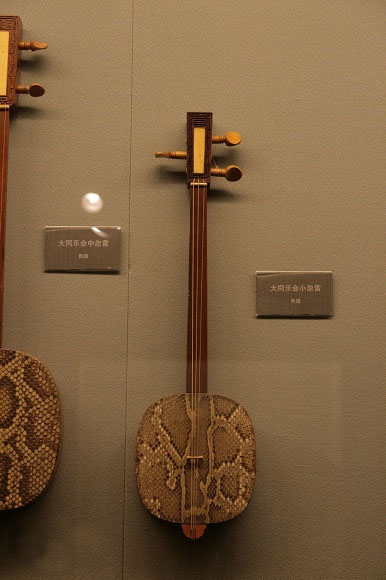Little Hulei's History
351 views · Organized by 咖喱麦兜 on 2022-02-16
Xiaohulei is a pipa-type stringed instrument that appeared in the Tang Dynasty. Longer history. As early as the 4th century AD, in the frescoes of Ajanta in western India, there were already stick-shaped lutes and pear-shaped lutes. Since the Han and Wei Dynasties, musicians from the Western Regions have settled down through the "Silk Road" to perform their art in the central region, and have brought the Western Regions Quxiang Pipa through the Qiuci.
Xiaohulei is a two-stringed musical instrument created by the Tang Dynasty musician Han Hong by referring to the form of the pipa in the Western Regions. It is more similar to the dragon-headed pipa in Nanzhao. In Nanzhao, China (now in Yunnan, southern Sichuan, and western Guizhou), there was a dragon-headed pipa. "Old Tang Book: Nanman Biography" (Volume 2, 2, 2, 2) contains: "Tang Zhenyuan period (AD 785-804) Nanzhao musical instrument has a dragon-headed pipa, such as the Qiuci system, and the length of the item is two feet six inches. Yu, the belly is six inches wide, two dragons face each other, and there are three pillars each, and the strings are as many." This rod-shaped, pear-shaped, dragon-headed pipa was introduced to Chang'an in mainland China through Chengdu, Sichuan during the Zhenyuan period.
The Little Hulei, made by Han Hong in the Tang Dynasty, collected by the Palace Museum in Beijing, has a history of more than 1,200 years. It has experienced the hands of famous people, and has been described in many documents. The vicissitudes of life, prosperity and decline, and finally return to the hands of the people.
When the envoy returned, Jiexian Yin recruited woodcutters to cut them down, take the stems, and return them. Called a good craftsman to cut it, but I don't know its name. Firm as purple stone, with golden threads intertwined. The craftsman said: 'For the Huqin groove, he cannot be combined. ’ So two qins were created, the bigger one was called “Da Hulei” and the smaller one was called “Xiao Hulei”. Because of the Emperor's words of music in the Biandian Hall, (Hu) then offered Da Hulei to the ban, and Xiao Hulei was in Qinrenfang. "
Xiaohulei is a two-stringed musical instrument created by the Tang Dynasty musician Han Hong by referring to the form of the pipa in the Western Regions. It is more similar to the dragon-headed pipa in Nanzhao. In Nanzhao, China (now in Yunnan, southern Sichuan, and western Guizhou), there was a dragon-headed pipa. "Old Tang Book: Nanman Biography" (Volume 2, 2, 2, 2) contains: "Tang Zhenyuan period (AD 785-804) Nanzhao musical instrument has a dragon-headed pipa, such as the Qiuci system, and the length of the item is two feet six inches. Yu, the belly is six inches wide, two dragons face each other, and there are three pillars each, and the strings are as many." This rod-shaped, pear-shaped, dragon-headed pipa was introduced to Chang'an in mainland China through Chengdu, Sichuan during the Zhenyuan period.
The Little Hulei, made by Han Hong in the Tang Dynasty, collected by the Palace Museum in Beijing, has a history of more than 1,200 years. It has experienced the hands of famous people, and has been described in many documents. The vicissitudes of life, prosperity and decline, and finally return to the hands of the people.

When the envoy returned, Jiexian Yin recruited woodcutters to cut them down, take the stems, and return them. Called a good craftsman to cut it, but I don't know its name. Firm as purple stone, with golden threads intertwined. The craftsman said: 'For the Huqin groove, he cannot be combined. ’ So two qins were created, the bigger one was called “Da Hulei” and the smaller one was called “Xiao Hulei”. Because of the Emperor's words of music in the Biandian Hall, (Hu) then offered Da Hulei to the ban, and Xiao Hulei was in Qinrenfang. "
Involving musical instruments
Xiaohulei (pinyin: Xiǎo hū léi) is an ancient Chinese plucked stringed musical instrument. Named for its pronunciation, Hu Hu Ruo Lei. Also known as the dragon head pipa or the two-string pipa. There is little publicity. The Palace Museum in Beijing has a collection of Xiao Hulei made in the Tang Dynasty, which is known as a rare treasure.
Guess you like
Organized by 小埋 on 2022-02-16
From the beginning of the establishment of the Middle Ages, through Xingyuan, Zhenyuan, Yongzhen, Yuanhe, Changqing, to the 45 years of the second year of Baoli, Xiaohulei has been hiding in the inner palace. At the time of Emperor Wenzong Li Ang in Tang Dynasty, there was a palace man, Zheng Nv, who was good at playing Xiao Hu Lei, and it only began its prosperous period.
read >>
Organized by 袁城 on 2022-02-15
Xiao Hulei was a precious musical instrument. According to legend, it has always been hidden in the emperor's palace. It was lost to the people, and later passed on, and it fell into the hands of a talented young man named Liang Houben.
read >>
 渝公网安备 50010702504639号
渝公网安备 50010702504639号